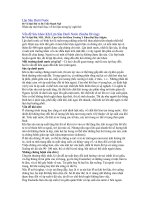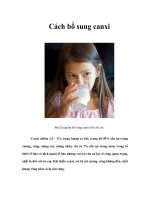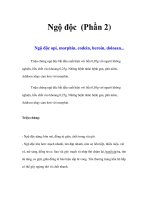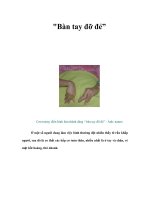Tài liệu Influenza A (H5N1): Prevention pptx
Bạn đang xem bản rút gọn của tài liệu. Xem và tải ngay bản đầy đủ của tài liệu tại đây (67.46 KB, 19 trang )
Influenza A (H5N1):
Prevention
Prof. Nguyen Duc Hien, MD, PhD
Director of NIITD, Vietnam
Introduction
•
Prevention of Infectious diseases
–
Measures
•
Vaccines/antiserum
•
Standard/universal precautions
•
Personal protective equipments
•
Prophylatic medications
•
Quarantine and isolation
Introduction
•
Prevention of Infectious diseases
–
Levels
•
In hospital
•
Close contacts
•
Community
•
Pandemics
Introduction
•
Prevention of Infectious diseases
–
Functions of:
•
Healthcare workers
–
Clinicians
–
Grassroot healthcare workers
•
Epidemiologists
•
Household members
•
Policy makers
Influenza A (H5N1)
•
Etiology: virus
–
Effectiveness of antivirals
•
Oseltamivir, zanamivir
•
Amantadine (?), Rimantadine (?)
•
Transmission
–
Route
•
Respiratory tract
•
Gastrointestinal tract
–
Methods
•
Droplets
•
Airborne (?)
Influenza A (H5N1)
•
Risk factors
–
A match case-control study from NIHE 2006
•
Design
–
28 case-patients
–
106 control-respondents
•
Results
–
Preparing sick/dead poultry ≤ 7 days before illness onset
–
Having sick/dead poultry in the household ≤ 7 days
before illness onset
–
Lack of an indoor water source
–
No clear evidence of human-human
transmission
Control Influenza A (H5N1)
•
Prerequisite
–
Control avian influenza in poultry
•
Vaccines
•
Early detecting poultry cases
•
Localizing outbreak areas
•
Destroying suspected poultry flocks
•
Future: centralization in raising/slautering
–
Control poultry-human contacts
•
Propagation/Health education
–
Symptomatic surveillance
•
Prophylaxis for poultry workers and household
members (?)
–
Oseltamivir 75 mg qd
Prevention: Vaccines
•
H5N1 vaccine: in studying
•
Yearly vaccine production
–
Antigen: H1N1, H3N2 and influenza B
•
Influenza antigen: shift and drift
–
Require yearly data from global influenza surveillance
–
Rate of vaccine failure ?
•
Type of Influenza vaccine
–
Killed vaccines
–
Live vaccines
Prevention: Vaccines
•
Recomendation
–
Groups to target FLU-A
•
Facilities
•
Likelihood of transmission to high risk persons
•
Underlying medical conditions
•
Age > 65 years/6-23 months
•
Poultry workers ???
–
Guidelines from WHO, CDC
–
Priority in pandemic situation ?
“If the pandemic were to start now,
we would have to rely on non-
vaccine measures for atleast 6
months Vaccines may only be
available for the second wave of
the pandemic Starting
preparation now is essential”
“Our goal should be to develop a
new cell culture-based vaccine that
includes antigens that are present in
all subtypes of influenza virus. that
do not change from year to year,
and that can be made available to
the entire world population”
(Osterholm, NEJM 2005)
Prevention: Standard/Universal
precautions
•
Simple but important measures
•
Must be applied to all patients receiving
care in hospitals
•
Require strengthening education for
healthcare workers
•
Developping countries:
–
Health education for patients’ ralatives
Prevention: personal protective
equipment
•
High-efficiency mask
–
European CE approved respirators
–
US NIOSH certified N-95
•
Gown
•
Face shield/google
•
Gloves
Prevention: prophylactic
medications
•
Medication
–
Oseltamivir 75 mg qd
•
In hospital
–
Close contacts without protective equipments
•
Patient’s ralatives
•
Healthcare workers
•
Community
–
Poultry workers contact with H5N1 poultry
–
Household members of H5N1 cases
Prevention: prophylactic
medications
•
Shortcoming issues
–
Stockpile:
•
How many courses and for how long
•
Strategies for drug turning over
–
Duration of prophylactic treatment
•
7 days ?
•
As long as 7 days after last contacts ?
–
Side effects ?
–
In outbreak areas
•
Oseltamivir must be given all population in the area that have
the first human H5N1 cases ?
Prevention: quarantine and
isolation
•
Manage suspected cases in seperated
room
–
Negative pressure room
–
Waste disposal inside
–
Each room has a buffer room
•
Patient beds
–
More than 1 m apart
–
Seperated by a physical barrier
Prevention: quarantine and
isolation
•
Limit the number of
–
Healthcare workers who have direct contact with the
patients
•
They should not look after other patients
–
Other hospital employees with access to the
environment of these patients
•
Cleaners
•
Laboratory personnel
–
Visitors
•
Provide them with appropriate personal protective equipment
and instruct them in its use
Prevention: quarantine and
isolation
•
Monitor body temperature and other symptoms
for 7 (or 14 ?) days after the last exposure:
–
Close contacts
–
Heathcare workers
•
Who have a fever > 38
0
C and who have had direct patient
contact should be treated immediately
•
All preventive measures for patients remain in
place after resolution of the fever.
–
Adults: for 7 days
–
Children: for 21 days
THANK YOU FOR
YOUR ATTENTION









